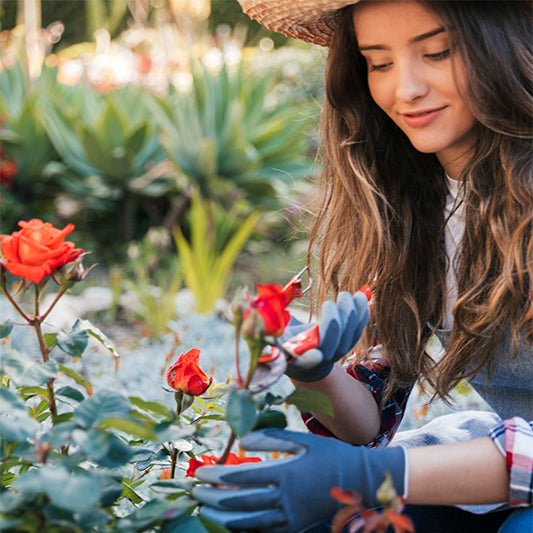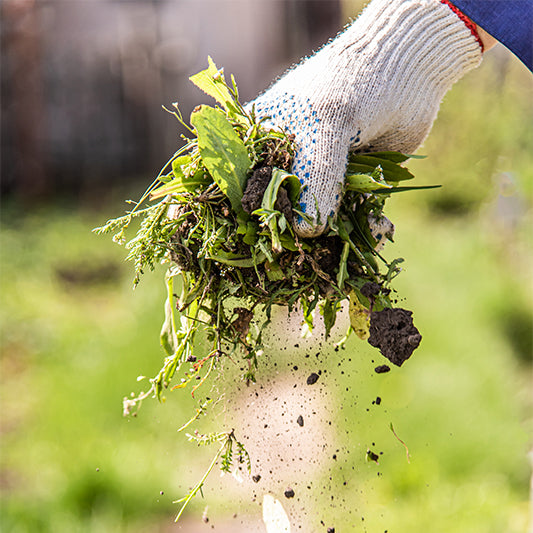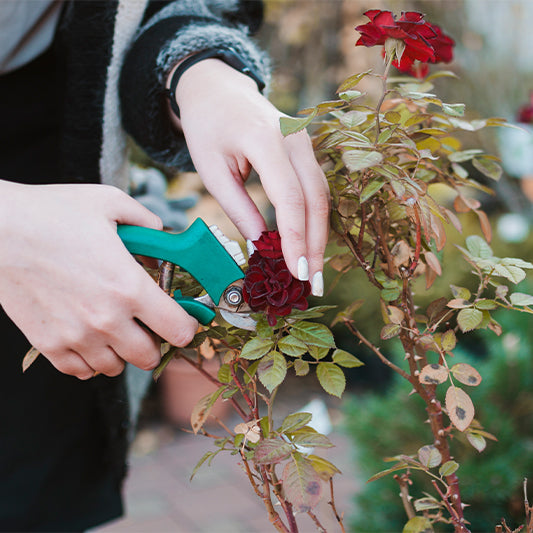10 Essential Tasks for Your June Garden: A To-Do List

June is the ideal time to get your garden looking its best. Whether you're a gardening enthusiast or just getting started, Whitakers Garden Centre has everything you need to get your garden into shape this month.
With a few essential tasks and some help from our experts, your garden will be thriving in no time! To get you started, here are 10 essential tasks to include on your June garden to-do list.
Prune flowering shrubs and roses to encourage healthy growth
In the garden world, pruning is one of the most important practices to encourage healthy growth and bloom. June is an ideal time to prune flowering shrubs and roses, particularly if you missed the winter pruning window. Take advantage of the warmer weather in June if you live in an area with unpredictable weather, like Knowsley, Merseyside, or Liverpool.
Basic tips for pruning roses first and foremost, cut back hard to promote strong growth and ensure plenty of room for new shoots to grow. You should also always cut to an outward-facing bud, as this helps prevent compacted growth and ensures a more open, airy plant.
Be sure to remove any closely positioned stems, as well as stubby 'snags' and thin, twiggy stems. This will help keep the plant's overall shape and ensure better airflow. It's worth noting that there are exceptions to the June pruning rule, such as with rambling roses, which should be pruned after flowering in summer. For advice specific to your roses, call our experts at 0151 426 6455.
In addition to pruning roses, June is also a good time to prune flowering shrubs. Just like with roses, it's important to remove any damaged, diseased, or dead wood and ensure you're not overcrowding any branches. Depending on the plant, it may be beneficial to prune hard to encourage a bushier growth habit, or to prune lightly to simply shape and maintain the plant's size. Ultimately, pruning in June is all about encouraging healthy growth and ensuring your plants look their best throughout the growing season. With a little know-how and a good pair of shears, your garden will be looking its best in no time.
Weed regularly
Weeding is an important task in any garden, and it becomes even more essential in June when everything is in full growth mode.
You need to keep your weeds under control or they will quickly choke out your vegetables, flowers, and other plants. But don't worry - weeding doesn't have to be a daunting task. With the right methods in place, you can keep your garden tidy and healthy throughout the entire summer.
One key to successful weeding is to do it regularly. This means taking a few minutes each day to walk around your garden and pull any visible weeds. The more often you do this, the less time-consuming it will be overall, as you won't have to deal with a huge backlog of weeds.
Another helpful tip is to weed after it rains, or after you've watered your garden. The moisture will help loosen the soil, making it easier to pull out the weeds. If you have a large garden or simply don't have the time to weed every day, you might consider using a mulch or weed suppressant fabric.
These materials can help prevent new weeds from sprouting up and make it easier to pull out any that do grow. By weeding regularly, you'll be giving your vegetables and other plants the best chance to grow and thrive.
Plus, you'll enjoy a tidier and more attractive garden all summer long.
Deadhead spent blooms on flowering plants to encourage continuous blooming
Deadheading your flowers is one of the easiest ways to promote the health and beauty of your garden. Deadheading is the process of removing the flowers that have wilted or faded away from the plant, to stimulate the growth of new blooms. Additionally, this enhances the aesthetic appeal of your garden and encourages your plants to thrive all year long. Identify the faded flower buds on your flowering plants.
Cut the stem just above the first healthy leaf or flower bud using sharp, clean scissors or pruning shears. You can also pinch off the flowers with your fingers if you have plants with numerous blooms, like petunias or marigolds. The spent blooms should be removed when they start to fade during the growing season. This prevents the plant from using valuable resources to produce seeds.
This will result in a longer blooming period for the plant and overall better health. You can also keep your garden looking neat and tidy by deadheading your flowers and discarding them in your compost bin or trash. Let your flowering plants continue to bloom this June by deadheading them!

Sow summer annuals and herbs for vibrant colours and fresh culinary delights
June is the perfect time to sow some summer annuals and herbs in your garden. Not only will they add vibrant colours to your outdoor space, but you can also enjoy fresh culinary delights by harvesting the herbs when they are fully grown.
If you want some easy-to-grow herbs this month, consider planting these herbs in your garden:
1. Basil - This fragrant herb is perfect for adding to pasta dishes, salads, and even pizzas. It prefers a sunny spot and well-draining soil.
2. Chives - Chives are a great addition to your herb garden and can be added to soups, stews, and even scrambled eggs. Although they are typically partial to a sunny spot, they can tolerate partial shade.
3. Coriander - This herb is a popular addition to Mexican, Asian, and Middle Eastern dishes. It prefers a cooler temperature and can be sown in partial shade.
4. Dill - This aromatic herb is perfect for adding flavour to fish, potato salad, and even pickles. It prefers a sunny spot with well-draining soil.
5. Mint - This herb is a refreshing addition to teas, cocktails, and even salads. It prefers a partially shaded spot and well-draining soil.
6. Parsley - This herb is a great addition to any dish and can even be used as a garnish. It prefers a partially sheltered location and well-drained soil.
When sowing these herbs, make sure to follow the instructions on the seed packets. Some herbs may require pre-soaking before sowing, while others may need to be sown directly in the ground. Once they start to grow, make sure to water them regularly and harvest them when they are fully grown for the best flavour.
Happy gardening!

Monitor and water your plants regularly
With warmer temperatures and less rain, keeping your plants hydrated in June is essential. As a general rule of thumb, aim to water your plants once or twice a week, depending on their specific needs. One of the most effective ways to ensure your plants are receiving enough water is to monitor them closely. Check the soil around your plants' roots regularly - if it feels dry to the touch, it's time to water.
If you have plants in containers, it's important to check their moisture levels even more frequently, as they tend to dry out faster. The key aspects of taking care of your plants are firstly, it's best to water them in the morning or evening, when the sun is less intense and the temperature is cooler.
This helps to prevent water from evaporating before it can be absorbed by your plants' roots. Another important tip is to water your plants deeply, rather than simply giving them a quick sprinkle. This allows the water to penetrate down to the roots, promoting strong, healthy growth. Avoid overwatering, however, as this can lead to waterlogged soil and root rot.
If you're going away for a few days, consider investing in a timer or asking a neighbour to water your plants in your absence. With a little bit of care and attention, your garden will continue to flourish throughout the summer months.
Apply a layer of mulch around your plants
Mulching is a vital component of gardening, especially during the hot summer months. Mulch serves several purposes, including reducing weed growth, retaining soil moisture, and providing nutrients to your plants. June is the perfect time to apply a layer of mulch to your garden, helping your plants thrive in the warm weather.
Start by clearing away any weeds or debris around your plants and then apply a 2-3 inch layer of organic mulch around the base of your plants. There are many types of organic mulch to choose from including wood chips, bark, and compost. Each type has its own unique properties and benefits, so choose the type that is best for your garden and plants.
The benefits of organic mulch for your garden are numerous. It helps keep the soil moist by reducing water evaporation and also helps regulate soil temperature. It also helps prevent soil erosion and protects your plants from damage caused by heavy rain and wind. As organic mulch breaks down over time, it provides essential nutrients to your plants. As the organic matter decomposes, it releases valuable nutrients into the soil, feeding your plants and promoting healthy growth.
Applying a layer of mulch around your plants not only provides practical benefits but also enhances the visual appeal of your garden. A neat layer of mulch gives your garden a polished, finished look. All in all, by applying a layer of mulch to your garden, you will promote healthy and resilient plants.

Train and support climbing plants by tying them to trellises or stakes
Climbing plants add a vertical dimension to your garden and are great for covering walls, trellises, and fences. However, they need some guidance and support to grow in the right direction.
Here are some tips to help you train and support your climbing plants:
1. Choose the right support: Depending on the type of climbing plant, you may need a trellis, stake, or wire frame to support it. Make sure it's strong enough to withstand the weight of the plant and any wind or rain.
2. Position the support: Place the support against the wall or fence where you want the plant to grow. Make sure it's firmly anchored in the ground and won't wobble or fall over.
3. Tie the stems: Gently tie the stems of the climbing plant to the support using twine or plant ties. Don't tie them too tightly, as this can damage the stems and restrict growth. Leave some slack so the stems can move and grow freely.
4. Train the stems: As the plant grows, guide the stems towards the support using gentle pressure. You can also use pruning shears to trim any stems that are growing in the wrong direction.
5. Check regularly: Check the ties and stems regularly to make sure they're not too tight or damaging the plant. Adjust them as necessary and remove any dead or damaged growth.
By training and supporting your climbing plants, you'll not only create a beautiful vertical garden, but also ensure the plant grows strong and healthy.
Don't forget to take some time to enjoy the view!
Harvest ripe fruits and vegetables
There's nothing quite like the satisfaction of harvesting ripe fruits and vegetables straight from your own garden. Nevertheless, it's crucial to know when and how to do it right.
Here are some tips for harvesting different types of produce:
- Pull carrots and beets gently from the ground, taking care not to damage them.
- Tomatoes and peppers should be picked when they are fully ripened, with a little give when squeezed gently.
- Leafy greens like lettuce and spinach can be harvested by cutting the outer leaves as needed.
- Fruits like strawberries and raspberries should be picked when they are fully red and easily detach from the plant.
When harvesting, use a sharp pair of garden shears or scissors to avoid damaging the plant. A good time to harvest is early in the morning or late at night when the plants are cooler, which preserves their freshness. Once you've harvested your produce, enjoy them in salads, smoothies, or cook them up in your favourite recipes.
Happy harvesting!
Keep an eye out for pests and diseases
The best thing you can do for your garden is to keep an eye out for pests and diseases. Catching a problem early on can make all the difference in preventing it from spreading and causing serious damage to your plants.
To help you stay on top of things, make sure to regularly inspect your plants for any signs of infestation or disease. This can include things like yellowing leaves, unusual spots or markings, or the presence of pests like aphids, slugs, or snails. If you do spot an issue, act quickly to address it.
In many cases, simply removing infected leaves or treating with a natural insecticide can help prevent the problem from spreading. However, more serious issues may require more intensive treatments, such as using a systemic insecticide or fungicide.
Of course, prevention is always the best approach when it comes to pests and diseases. To minimize the risk of an infestation or outbreak, make sure to keep your garden clean and tidy, regularly remove any dead or dying plant material, and avoid overcrowding plants.
You may also want to consider using companion planting techniques to help repel pests naturally. By staying vigilant and proactive, you can help ensure your garden stays healthy and beautiful all season long. To avoid any potential issues, keep your eyes open and nip them in the bud before they get a chance to grow.
Happy gardening!

Create a welcoming haven for pollinators by planting nectar-rich flowers
Bees, butterflies, and hummingbirds are vital to a healthy garden, as they spread the pollen that would otherwise wither without such pollination. Creating a haven for pollinators is not only beneficial to your garden, but also to the environment as a whole.
Plant nectar-rich flowers in your garden to attract pollinators. Some of the best flowers for attracting bees and butterflies include lavender, salvia, echinacea, and butterfly bush.
For hummingbirds, try planting tubular flowers such as fuchsia and bee balm. When selecting your plants, it's important to choose a variety that blooms throughout the season, providing a continuous source of food for the pollinators.
In addition to planting flowers, you can also create habitats for pollinators. Bee hotels, which provide nesting sites for solitary bees, are easy to make and can be placed in a sunny spot in your garden. You can also leave a patch of your lawn uncut to provide habitat for ground-nesting bees.
Lastly, avoid using pesticides and herbicides in your garden, as they can harm pollinators. Instead, opt for natural methods of pest control, such as companion planting and hand-picking pests.
By creating a welcoming haven for pollinators, you can help to ensure the health and vitality of your garden, and support the important role that these creatures play in our ecosystem.
- James Beesley





